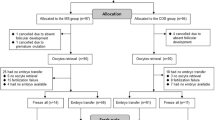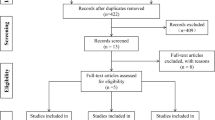Abstract
The incidence of poor ovarian responders (PooResp) among infertile women undergoing controlled ovarian stimulation (COS) for in vitro fertilization (IVF) has been estimated at 9–24%, but according to recent reviews, it seems to have slightly increased in the last years [1]. Despite the huge number of trials that have been performed and published in the last two decades with the aim to find more efficient stimulation protocols for the management of PooResp, systematic reviews suggest that we still have insufficient evidence to recommend a specific treatment, the poor ovarian response remaining one of the most challenging tasks in reproductive medicine [2].
Access this chapter
Tax calculation will be finalised at checkout
Purchases are for personal use only
Similar content being viewed by others
References
Polyzos NP, Nwoye M, Corona R, et al. Live birth rates in Bologna poor responders treated with ovarian stimulation for IVF/ICSI. Reprod Biomed Online. 2014;28:469–74.
Ubaldi F, Vaiarelli A, D’nna R, et al. Management of poor responders in IVF: is there anything new? Biomed Res Int. 2014;352098.
Ferraretti AP, La Marca A, Fauser BC, et al. ESHRE consensus on the definition of poor response to ovarian stimulation for in vitro fertilization: the Bologna criteria. Hum Reprod. 2011;26:1616–24.
Haas J, Zilberberg E, Machtinger R, et al. Do poor responder patients benefit from increasing the daily gonadotropin dose during controlled ovarian hyperstimulation for IVF? Gynecol Endocrinol. 2015;31:79–82.
Karande VC, Jones GS, Veeck LL, et al. Highdose follicle-stimulating hormone stimulation at the onset of the menstrual cycle does not improve the in vitro fertilization outcome in low-responder patients. Fertil Steril. 1990;53:486–9.
van Hooff MHA, Alberda AT, Huisman GJ, et al. Doubling the human menopausal gonadotrophin dose in the course of an in-vitro fertilization treatment cycle in low responders: a randomised study. Hum Reprod. 1993;8:369–73.
Land JA, Yarmolinskaya MI, Dumoulin JCM, et al. High-dose human menopausal gonadotropin stimulation in poor responders does not improve in vitro fertilization outcome. Fertil Steril. 1996;65:961–5.
Hofmann GE, Toner JP, Muasher SJ, et al. Highdose follicle-stimulating hormone (FSH) ovarian stimulation in low-responder patients for in vitro fertilization. J In Vitro Fert Embryo Transf. 1989;6:285–9.
Berkkanoglu M, Ozgur K. What is the optimum maximal gonadotropin dosage used in microdose flare-up cycles in poor responders? Fertil Steril. 2010;94:662–5.
Fauser BC, Nargund G, Andersen AN, et al. Mild ovarian stimulation for IVF: 10 years later. Hum Reprod. 2010;25:2678–84.
Revelli A, Casano S, Salvagno F, et al. Mild is better? Advantages and disadvantages of “mild” ovarian stimulation for human in vitro fertilization. Reprod Biol Endocrinol. 2011;16:9–25.
Adashi EY. Clomiphene Citrate: mechanisms and sites of action- a hypothesis revisited. Fertil Steril. 1984;42:331–43.
Yanaihara A, Yorimitsu T, Motoyama H, et al. The decrease of serum luteinizing hormone level by a gonadotropin releasing hormone antagonist following the mild IVF stimulation protocol for IVF and its clinical outcome. J Assist Reprod Genet. 2008;25:115–8.
Craft I, Gorgy A, Hill J, et al. Will GnRH antagonists provide new hope for patients considered “difficult responders” to GnRH protocols? Hum Reprod. 1999;14:2959–62.
Takahashi K, Mukaida T, Tomiyana T, et al. GnRH antagonist improved blastocyst quality and pregnancy outcome after multiple failures of IVF/ICSI-ET with a GnRH agonist protocol. J Assist Reprod Genet. 2004;21:317–22.
Revelli A, Chiadò A, Dalmasso P, et al. “Mild” vs. “long” protocol for controlled ovarian hyperstimulation in patients with expected poor ovarian responsiveness undergoing in vitro fertilization (IVF): a large prospective randomized trial. J Assist Reprod Genet. 2014;31:809–15.
Mochtar MH, Van der Veen A, Ziech M et al. Recombinant Luteinizing Hormone (rLH) for controlled ovarian hyperstimulation in assisted reproductive cycles. Cochrane Database Syst Rev. 2007;18:CD005070.
Yoo JH, Cha SH, Park CW, et al. Comparison of mild ovarian stimulation with conventional ovarian stimulation in poor responders. Clin Exp Reprod Med. 2011;38:159–63.
Oride A, Kanasaki H, Miyazaki K. Comparison of human menopausal gonadotropin stimulation with and without clomiphene for in vitro fertilization in poor responders. J Obstet Gynaecol. 2015;35:163–7.
Mitwally MF, Casper RF. Use of an aromatase inhibitor for induction of ovulation in patients with an inadequate response to clomiphene citrate. Fertil Steril. 2001;75:305–9.
Mitwally MFM, Casper RF. Aromatase inhibitors for the treatment of infertily. Expert Opin Investig Drugs. 2003;12:353–71.
Fisher SA, Reid RL, Van Vugt DA, et al. A randomized double-blind comparison of the effects of clomiphene citrate and the aromatase inhibitor letrozole on ovulatory function in normal women. Fertil Steril. 2002;78:280–5.
Weil S, Vendola K, Zhou J, et al. Androgen and follicle-stimulating hormone interactions in primate ovarian follicle development. J Clin Endocrinol Metab. 1999;84:2951–6.
Yarali H, Esinler I, Polat M, et al. Antagonist/letrozole protocol in poor ovarian responders for intracytoplasmic sperm injection: a comparative study with the microdose flare-up protocol. Fertil Steril. 2009;92:231–5.
Biljan MM, Hcmmings R, Brassard N. The outcome of 150 babies following the treatment with letrozole or lerozole and gonadotrophins. Fertil Steril. 2005;84(Suppl.):1033.
Gill SK, Moretti M, Koren G. Is the use of letrozole to induce ovulation teratogenic? Cana Fam Phys. 2008;54:353–4.
Rockville MD. FDA oncology tools product label details for administration of letrozole.http://www.accessdata.fda.gov/scripts/cder/onctools/administer.cfm?GN=letrozole/. Retrieved 15.03.08 2003.
Tulandi T, Martin J, Al-Fadhli R, et al. Congenital malformations among 911 newborns conceived after infertility treatment with letrozole or clomiphene citrate. Fertil Steril. 2006;85:1761–5.
Requena A, Herrero J, Landeras J, et al. Use of letrozole in assisted reproduction: a systematic review and meta-analysis. Hum Reprod Update. 2008;14:571–82.
Mitwally MFM, Casper RF. Aromatase inhibition improves ovarian response to follicle-stimulating hormone in poor responders. Fertil Steril. 2002;77:776–80.
Mitwally MF, Casper RF. Aromatase inhibition reduces gonadotrophin dose required for controlled ovarian stimulation in women with unexplained infertility. Hum Reprod. 2003;18:1588–97.
Healey S, Tan SL, Tulandi T, et al. Effects of letrozole on superovulation with gonadotropins in women undergoing intrauterine insemination. Fertil Steril. 2003;80:1325–9.
Song Y, Li Z, Wu X, et al. Effectiveness of the antagonist/letrozole protocol for treating poor responders undergoing in vitro fertilization/intracytoplasmic sperm injection: a systematic review and meta-analysis. Ginecol Endocrinol. 2014;30:330–4.
Davar R, Oskouian H, Armadi S, et al. GnRH antagonist/letrozole versus microdose GnRH agonist flare protocol in poor responders undergoing in vitro fertilization. J Obstet Gynecol. 2010;49:297–301.
Garcia-Velasco JA, Moreno L, Pacheco A, et al. The aromatase inhibitor letrozole increases the concentration of intraovarian androgens and improves in vitro fertilization outcome in low responder patients: a pilot study. Fertil Steril. 2005;84:82–7.
Ozmen B, Sonmezer M, Atabekoglu CS, et al. Use of aromatase inhibitors in poor-responder patients receiving GnRH antagonist protocols. Reprod Biomed Online. 2009;19:478–85.
Schoolcraft WB, Surrey ES, Minjarez DA, et al. Management of poor responders: can outcomes be improved with a novel gonadotropin-releasing hormone antagonist/letrozole protocol? Fertil Steril. 2008;89:151–6.
Verpoest WMJA, Kolibianakis E, Papanikolaou E, et al. Aromatase inhibitors in ovarian stimulation for IVF/ICSI: a pilot study. Reprod Biomed Online. 2006;13:166–72.
Goswami SK, Das T, Chattopadhyay R, et al. A randomized single-blind controlled trial of letrozole as a low-cost IVF protocol in women with poor ovarian response: a preliminary report. Hum Reprod. 2004;19:2031–5.
Lee VCY, Chan CC, Ng EH, et al. Sequential use of letrozole and gonadotrophin in women with poor ovarian reserve: a randomised controlled trial. Reprod Biomed Online. 2011;23:380–8.
Merci R, Caserta D, Dolo V, et al. GnRH antagonist in IVF poor- responder patients: results of a randomied trial. Reprod Biomed Online. 2005;11:189–1993.
Kenigsberg D, Littman BA, Hodgen GD. Medical hypophysectomy: I. Dose-response using a gonadotropin releasing hormone antagonist. Fertil Steril. 1984;42:112–5.
Mohsen IA, El Din RE. Minimal stimulation protocol using letrozole versus microdose flare up GnRH agonist protocol in women with poor ovarian response undergoing ICSI. Gynecol Endocrinol. 2013;29:105–8.
Author information
Authors and Affiliations
Corresponding author
Editor information
Editors and Affiliations
Rights and permissions
Copyright information
© 2017 Springer International Publishing AG
About this chapter
Cite this chapter
Revelli, A., Casano, S., Benedetto, C. (2017). Mild Stimulation Protocol for Poor Ovarian Responders Undergoing IVF. In: Chian, RC., Nargund, G., Huang, J. (eds) Development of In Vitro Maturation for Human Oocytes. Springer, Cham. https://doi.org/10.1007/978-3-319-53454-1_16
Download citation
DOI: https://doi.org/10.1007/978-3-319-53454-1_16
Published:
Publisher Name: Springer, Cham
Print ISBN: 978-3-319-53452-7
Online ISBN: 978-3-319-53454-1
eBook Packages: MedicineMedicine (R0)




